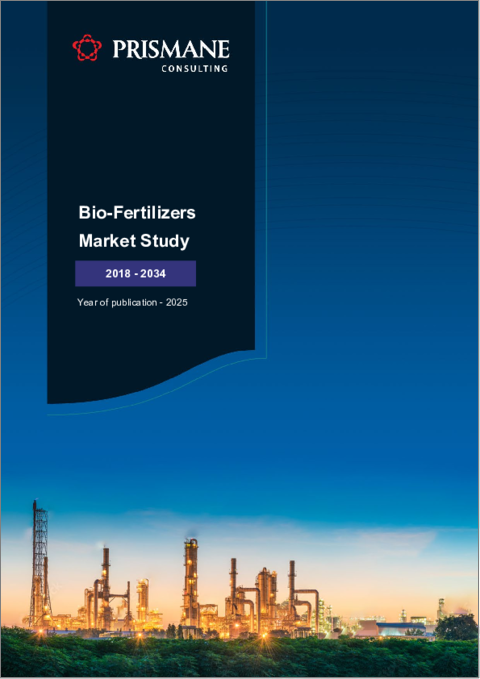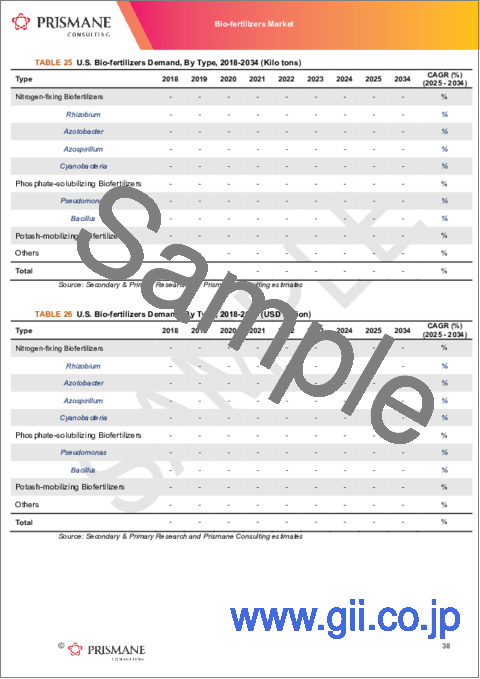|
|
市場調査レポート
商品コード
1752362
バイオ肥料の世界市場の需要、予測分析(2018年~2034年)Global Bio-Fertilizers Market Demand & Forecast Analysis, 2018-2034 |
||||||
|
|||||||
| バイオ肥料の世界市場の需要、予測分析(2018年~2034年) |
|
出版日: 2025年04月14日
発行: Prismane Consulting
ページ情報: 英文 127 Pages
納期: 3~5営業日
|
全表示
- 概要
- 目次
バイオ肥料の需要の分析
バイオ肥料のタイプの中では、マメ科植物と共生関係を結び、大気中の窒素を固定して植物が利用できるようにする能力を持つ根粒菌が、もっとも広く使われているバイオ肥料の1つとして際立っています。アゾトバクターとアゾスピリラムは自由生活性の窒素固定バクテリアで、マメ科植物以外にもさまざまな作物に恩恵をもたらしています。水田でよく使われる藍藻は、窒素と有機物で土壌を豊かにします。菌根菌は植物の根と共生関係を結び、養分と水の吸収を促進します。このようにさまざまなタイプのバイオ肥料を利用できるため、農家はそれぞれの農業ニーズや土壌条件にもっとも適したバイオ肥料を選択することができます。
バイオ肥料は、畑作物、果物・野菜、特殊作物、芝生などのさまざまな作物カテゴリで広く使用されています。小麦、トウモロコシ、コメなどの畑作物は、大規模農場で収量と土壌の健全性を高めるニーズにより、バイオ肥料使用の大きなシェアを占めています。果物・野菜部門もバイオ肥料の恩恵を受けており、バイオ肥料が栄養分の取り込みや耐病性を向上させ、農産物の品質向上につながっています。花、香辛料、薬用植物などの特殊作物では、製品の純度を損なうことなく土壌の肥沃度を維持するバイオ肥料への依存度が高まっています。造園やゴルフ場での芝生への施用も成長している分野の1つで、バイオ肥料は化学品の投入を減らしながら青々とした芝生を維持するのに役立っています。
地域市場の考察
地理的には、広大な農業基盤を持ち、持続可能な農法の採用が拡大しているため、アジア太平洋がバイオ肥料市場を独占しています。インドや中国といった国々は、有機農業や環境にやさしい農業を推進する政府の取り組みによって市場をリードしています。この地域はまた、土壌の微生物活動を支援し、バイオ肥料の性能を高める良好な気候条件の恩恵を受けています。
北米と欧州は、有機食品消費の増加と厳格な環境規制によって着実な成長を示しています。これらの地域には、新しいバイオ肥料製品の革新と商業化に寄与する先進の研究開発施設もあります。ラテンアメリカ、アフリカ、中東は、認知度とインフラ支援が向上していることから、大きな可能性を秘めた新興市場となっています。
主要市場企業
バイオ肥料産業は競合が激しく、幅広い製品を提供する複数の既存企業で構成されています。この分野の注目すべき企業には、Novozymes、National Fertilizers Limited、Madras Fertilizers Limited、Gujarat State Fertilizers & Chemicals、Rizobacter Argentinaなどがあります。これらの企業は、さまざまな作物や気候条件に合わせた高品質で効率的なバイオ肥料を開発する研究に投資しています。各社の活動には、製品処方の改良、生産能力の拡大、より幅広い顧客層を獲得するための流通網の強化などが含まれます。
バイオ肥料市場の促進要因
複数の要因がバイオ肥料市場を前進させています。化学肥料の環境被害に対する農家の意識の高まりが、より持続可能な代替肥料への移行を促しています。世界各国の政府は、バイオ肥料使用に対する補助金や奨励金を提供することで有機農法を推進しており、これが市場成長を後押ししています。さらに、世界人口の増加により、土壌の健全性と環境の持続可能性を維持しながら作物の収量を増やすことが農業システムに求められています。バイオ肥料は、作物の生産性を自然に向上させることで、この課題に対するソリューションを提供します。
もう1つの重要な促進要因は、有機食品に対する需要の高まりです。消費者はますます健康と環境上の懸念を優先するようになっており、農家や食品メーカーに環境にやさしい農法を採用するよう促しています。こうした消費者主導の需要は、農業生産におけるバイオ肥料の使用をさらに後押ししています。さらに、継続的な研究と技術革新により、より効率的な特定作物向けのバイオ肥料が開発され、その効果と採用率が高まっています。
当レポートでは、世界のバイオ肥料市場について調査分析し、市場力学と産業動向、各セグメントの需要、メーカーのプロファイルなどの情報を提供しています。
目次
第1章 イントロダクション
第2章 市場の要約
- 市場の進化
- 需要の概要
- 産業構造
- 戦略上の問題
- 最終用途の動向
- 成長予測
第3章 経済とエネルギーの見通し
- GDPと人口動態
- 金融政策と財政政策
- 原油生産と価格
- 天然ガス
- 電気料金
第4章 最終用途部門の実績
- 農業
- その他
第5章 バイオ肥料のイントロダクションと市場の概要
- 製品の説明
- グレードと特性
- 原材料
- 製造プロセス
- 環境問題
- バリューチェーン
- 用途
第6章 市場力学と産業動向
- 市場力学
- 促進要因
- 抑制要因
- 機会
- 課題
第7章 世界のバイオ肥料需要の分析:タイプ別、用途別(数量と金額)(2018年~2034年)
- 戦略上の問題とCOVID-19の影響
- 需要の分析と予測(2018年~2034年)
- 需要
- 需要成長率
- 促進要因の分析
- 世界のバイオ肥料市場:タイプ別
- 根粒菌
- アゾトバクター
- アゾスピリラム
- 藍藻
- 菌根菌
- その他
- 世界のバイオ肥料市場:用途別
- 畑作物
- 果物・野菜
- 特殊作物
- 芝生
- その他
第8章 需要の分析と市場のレビュー:地域/国別(数量と金額)(2018年~2034年)
- 戦略上の問題とCOVID-19の影響
- 需要の分析と予測(2018年~2034年)
- 需要
- 需要成長率
- バイオ肥料市場:タイプ別
- バイオ肥料市場:用途別
- 北米
- 米国
- カナダ
- メキシコ
- 西欧
- ドイツ
- フランス
- イタリア
- 英国
- スペイン
- その他の西欧
- 中欧・東欧
- ロシア
- ポーランド
- その他の中欧・東欧
- アジア太平洋
- 中国
- 日本
- インド
- 韓国
- その他のアジア太平洋
- 中南米
- 中東・アフリカ
第9章 価格分析
第10章 主な戦略上の問題と事業機会の評価
- 市場の魅力の評価
- 見通しとターゲット市場の調査
第11章 戦略的推奨と提案
第12章 企業分析
- バイオ肥料メーカーのプロファイル/企業分析
- 基本詳細
- 本社、主要市場
- 所有
- 企業の財務
- 製造拠点
- 世界の売上
- 総従業員数
- 製品ポートフォリオ/サービス/ソリューション
- 採用された主な事業戦略とPrismane Consultingの概要
- 近年の発展
- 対象企業
- Novozymes
- National Fertilizers Limited
- Madras Fertilizers Limited
- Gujarat State Fertilizers & Chemicals
- Rizobacter Argentina
- その他のメーカー
第13章 付録
The global bio-fertilizers market has been steadily gaining traction as farmers and agricultural industries shift toward more sustainable and eco-friendly farming practices. Bio-fertilizers are natural substances containing living microorganisms that enhance soil fertility and promote healthy plant growth by increasing the availability of essential nutrients. Unlike chemical fertilizers, bio-fertilizers improve soil health over time without causing pollution or damaging the environment. This growing preference for sustainable agriculture is projected to drive the bio-fertilizers demand in the forecast period.
Bio-fertilizers come in various types, each playing a unique role in enhancing soil and plant health. Common types include Rhizobium, Azotobacter, Azospirillum, Blue Green Algae, Mycorrhizal Fungi, and other beneficial microbes. Each of these microbes has a distinct function, from nitrogen fixation to phosphate solubilization, helping crops absorb nutrients more efficiently. This diversity in bio-fertilizer types allows them to be tailored to specific crops, soils, and climates, which adds to their effectiveness and appeal among farmers.
Bio-fertilizers demand analysis
Among the types, Rhizobium stands out as one of the most widely used bio-fertilizers due to its ability to form a symbiotic relationship with leguminous plants, fixing atmospheric nitrogen and making it accessible to plants. Azotobacter and Azospirillum are free-living nitrogen-fixing bacteria that benefit a wide variety of crops beyond legumes. Blue Green Algae, often used in paddy fields, enriches the soil with nitrogen and organic matter. Mycorrhizal fungi form symbiotic associations with plant roots, enhancing nutrient and water absorption. The availability of these varied types enables farmers to select bio-fertilizers that best fit their agricultural needs and soil conditions.
Bio-fertilizers are widely used across different crop categories, including field crops, fruit and vegetable crops, specialty crops, turf, and others. Field crops such as wheat, maize, and rice represent a significant share of bio-fertilizer usage, driven by the need to enhance yields and soil health on large-scale farms. The fruit and vegetable sector also benefits from bio-fertilizers, which improve nutrient uptake and disease resistance, leading to better quality produce. Specialty crops, including flowers, spices, and medicinal plants, increasingly rely on bio-fertilizers to maintain soil fertility without compromising product purity. Turf applications in landscaping and golf courses are another growing area, where bio-fertilizers help maintain lush green grass with reduced chemical inputs.
Regional Insights
Geographically, Asia-Pacific dominates the bio-fertilizers market due to the region's vast agricultural base and growing adoption of sustainable farming practices. Countries such as India and China are leading markets, driven by government initiatives to promote organic and eco-friendly farming. The region also benefits from favorable climatic conditions that support microbial activity in soils, enhancing bio-fertilizer performance.
North America and Europe are witnessing steady growth fueled by increasing organic food consumption and stringent environmental regulations. These regions are also home to advanced research and development facilities that contribute to the innovation and commercialization of new bio-fertilizer products. Latin America, Africa, and the Middle East present emerging markets with significant potential, as awareness and infrastructural support improve.
Key Market Players
The bio-fertilizers industry is competitive and comprises several established players who offer a wide range of products. Some of the notable companies in this space include Novozymes, National Fertilizers Limited, Madras Fertilizers Limited, Gujarat State Fertilizers & Chemicals, and Rizobacter Argentina. These companies are investing in research to develop high-quality, efficient bio-fertilizers tailored to various crops and climatic conditions. Their efforts include improving product formulations, expanding production capacities, and enhancing distribution networks to reach a broader customer base.
Bio-fertilizers Market Drivers
Several factors are propelling the bio-fertilizers market forward. The increasing awareness among farmers about the environmental hazards of chemical fertilizers has encouraged a shift toward more sustainable alternatives. Governments worldwide are promoting organic farming practices by offering subsidies and incentives for bio-fertilizer usage, which has boosted market growth. Additionally, the rising global population has put pressure on agricultural systems to increase crop yields while maintaining soil health and environmental sustainability. Bio-fertilizers offer a solution to this challenge by improving crop productivity naturally.
Another important driver is the growing demand for organic food products. Consumers are increasingly prioritizing health and environmental concerns, pushing farmers and food producers to adopt eco-friendly practices. This consumer-driven demand further encourages the use of bio-fertilizers in agricultural production. Moreover, ongoing research and innovation have led to the development of more efficient and crop-specific bio-fertilizers, increasing their effectiveness and adoption rates.
Table of Contents
1. Introduction
- Scope
- Market Coverage
- Type
- Application
- Regions
- Countries
- Years Considered
- Historical - 2018 - 2023
- Base - 2024
- Forecast Period - 2025 - 2034
- Research Methodology
- Approach
- Research Methodology
- Prismane Consulting Market Models
- Assumptions & Limitations
- Abbreviations & Definitions
- Conversion Factors
- Data Sources
2. Market Synopsis
- Market Evolution
- Demand Overview
- Industry Structure
- Strategic Issues
- End-use Trends
- Growth Forecast
3. Economic & Energy Outlook
- GDP and Demographics
- Monetary & Fiscal Policies
- Crude Oil Production and prices
- Natural Gas
- Electricity Prices
4. End-use Sector Performance
- Agriculture
- Others
5. Introduction to Bio-Fertilizers and Market Overview
- Product Description
- Grades & Properties
- Raw Material
- Manufacturing Process
- Environmental Issues
- Value Chain
- Applications
6. Market Dynamics and Industry Trends
- Market Dynamics
- Drivers
- Restraints
- Opportunities
- Challenges
7. Global Bio-Fertilizers Demand Analysis, By Type, By Application (Volume, Value) (2018 - 2034)
- Strategic Issues and COVID-19 Impact
- Demand Analysis and Forecast (2018 - 2034)
- Demand
- Demand Growth Rate (%)
- Driving Force Analysis
- Global Bio-Fertilizers Market, By Type
- Rhizobium
- Azotobacter
- Azospirilium
- Blue Green Algae
- Mycorrhizal Fungi
- Others
- Global Bio-Fertilizers Market, By Application
- Field Crops
- Fruit & Vegetable Crops
- Specialty Crops
- Turf
- Others
8. Demand Analysis and Market Review, By Region, By Country (Volume, Value), (2018-2034)
- Strategic Issues and COVID-19 Impact
- Demand Analysis and Forecast (2018 - 2034)
- Demand
- Demand Growth Rate (%)
- Bio-Fertilizers Market, By Type
- Bio-Fertilizers Market, By Application
Note: Demand Analysis has been provided for all major Regions / Countries as mentioned below. The demand (consumption) split by type and application has been provided for each of the countries / regions in Volume (Kilo tons) and Value (USD Million).
- North America
- USA
- Canada
- Mexico
- Western Europe
- Germany
- France
- Italy
- United Kingdom
- Spain
- Rest of Western Europe
- Central & Eastern Europe
- Russia
- Poland
- Rest of Central & Eastern Europe
- Asia-Pacific
- China
- Japan
- India
- South Korea
- Rest of Asia-Pacific
- Central & South America
- Middle East & Africa
Note: CAGR will be calculated for all type and applications to arrive at the regional / global demand growth for the forecast period (2025 - 2034)
9. Pricing Analysis
10. Key Strategic Issues and Business Opportunity Assessment
- Market Attractiveness Assessment
- Prospective & Target Market Study
11. Strategic Recommendation & Suggestions
12. Company Analysis
- Bio-Fertilizers Manufacturers Profiles/ Company Analysis
- Basic Details
- Headquarter, Key Markets
- Ownership
- Company Financial
- Manufacturing Bases
- Global Turnover
- Total Employee
- Product Portfolio / Services / Solutions
- Key Business Strategies adopted and Prismane Consulting Overview
- Recent Developments
- Companies Covered -
- Novozymes
- National Fertilizers Limited
- Madras Fertilizers Limited
- Gujarat State Fertilizers & Chemicals
- Rizobacter Argentina
- Other Manufacturers
Note: This section includes company information, company financials, manufacturing bases and operating regions. Company financials have been mentioned only for those companies where financials were available in SEC Filings, annual reports, or company websites. All the reported financials in this report are in U.S. Dollars. Financials reported in other currencies have been converted using average currency conversion rates. Company profiles may include manufacturers, suppliers, and distributors.
13. Appendices
- Demand - Regions
- Demand - Countries






